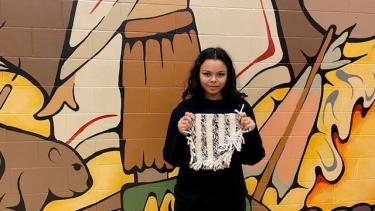
82% School Completion – Along the Path to Success
We are fortunate to have a dedicated and caring staff supporting our Indigenous students in our district who utilize a variety of creative approaches to do whatever it takes to support students to achieve success in our schools, develop their cultural identities and advocate for equitable access to every opportunity. Our ultimate mandate in Indigenous Education is to graduate students and to prepare them for a happy and fulfilling adulthood. We are delighted to share the 82% school completion rate of Indigenous students and celebrate the successes of each of our graduates and their families.
The most joyful components of my role have been witnessing students who have persevered and succeeded in their goals and having the privilege to work alongside them at Mámele’awt, the children’s house. Layla Ali completed her final course with us and successfully graduated with her Dogwood Certificate this past semester, and I would like to share a snip of her final project as she learned about Stó:lō Weaving.
“The use of natural materials like cedar bark, cattail leaves, woolly dogs and mountain goat wool are traced back to the beginnings of the Stó:lō people. Not only were these materials native to the local territory, but they also have significant cultural values. Weavings are used for ceremonial and practical purposes. Mats, bags, and baskets are useful items for gathering, fishing, and hunting. Weaved blankets are used for ceremonial reasons. When people gather, and one of their own is blanketed, this signifies that they are now united as one heart and one mind. They are claimed and supported as part of the community. Blanketing ceremonies can be brought up on namings, coming-of-age puberty rights, marriages, and funerals. They signify important milestones.
Stó:lō weaving is more than just a craft; it is a way of life that preserves traditional knowledge, strengthens ties between Elders and youth, and honours Indigenous identity by embracing and respecting the art of weaving. We can look back at our hardships and be grateful that our people didn’t give up so I can be here today, weaving this piece.”
Each June, we hold a special blanketing ceremony to honour our graduates following these important traditions. For Layla and the other Indigenous graduates and to the Indigenous Support Workers and Teachers for Indigenous Success, we hold our hands up to you! Well done!
DARLENE MACDONALD, DISTRICT PRINCIPAL
Indigenous Education Department